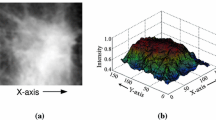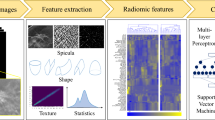Abstract
The most common cancer among women in the western world is breast cancer. Early detection of lesions greatly influences the progress and success of its treatment. Digital breast tomosynthesis (DBT) is a new imaging technique that facilitates a three-dimensional reconstruction of the breast. DBT reduces superimposition of breast tissues and provides better insight into the breast compared to the common digital mammography. In order to assist radiologists with the examination and assessment of the large amount of DBT data, a computer aided detection (CADe) of focal lesions can be an essential tool, leading to increased sensitivity and specificity. We present and compare two different approaches for a fully automated detection of lesions in DBT data using voxel-wise classification, one being the state of the art and the other one an enhancement. Multiple difference of Gaussians detect lesions based on their common higher intensity and contrast in relation to surrounding tissue. A gradient orientation analysis detects round and spiculated lesions, even when they are weak in contrast and intensity. By combining these features and using a support vector machine, a classification performance of 88% can be achieved.
Access this chapter
Tax calculation will be finalised at checkout
Purchases are for personal use only
Preview
Unable to display preview. Download preview PDF.
Similar content being viewed by others
References
Cancer facts & Figs. 2012. American Cancer Society; 2012.
Singh S, Baydush A, Harrawood B, et al. Mass detection in mammographic ROIs using Watson filters. Procs SPIE. 2006.
Wittenberg T, Wagner F, Gryanik A. Towards a computer assisted diagnosis system for digital breast tomosynthesis. Biomed Tech. 2012.
Smith A. Fundamentals of Breast Tomosynthesis; 2008. Available from: http://www.hologic.com/de/.
Good WF, Abrams GS, Catullo VJ, et al.. Digital breast tomosynthesis: a pilot observer study; 2012.
Borsdorf A. Adaptive filtering for noise reduction in X-ray computed tomography; 2009.
Universit¨atsklinik Erlangen. Brust-Tomosynthesedaten der IMoDe (Imaging and Molecular Detection); 2013. Studie der Universit¨atsklinik Erlangen, M¨arz 2013.
Prinzen M. Lokalisation von Vegetation in Bildern von Architekturumgebungen. Bachelor-Thesis, Universit¨at Koblenz-Landau; 2009.
te Brake GM. Computer aided detection of masses in digital mammograms; 2000.
Author information
Authors and Affiliations
Corresponding author
Editor information
Editors and Affiliations
Rights and permissions
Copyright information
© 2014 Springer-Verlag Berlin Heidelberg
About this chapter
Cite this chapter
Prinzen, M., Wagner, F., Nowack, S., Schulz-Wendtland, R., Paulus, D., Wittenberg, T. (2014). Computer-Aided Detection of Lesions in Digital Breast Tomosynthesis Images. In: Deserno, T., Handels, H., Meinzer, HP., Tolxdorff, T. (eds) Bildverarbeitung für die Medizin 2014. Informatik aktuell. Springer, Berlin, Heidelberg. https://doi.org/10.1007/978-3-642-54111-7_33
Download citation
DOI: https://doi.org/10.1007/978-3-642-54111-7_33
Published:
Publisher Name: Springer, Berlin, Heidelberg
Print ISBN: 978-3-642-54110-0
Online ISBN: 978-3-642-54111-7
eBook Packages: Computer Science and Engineering (German Language)




